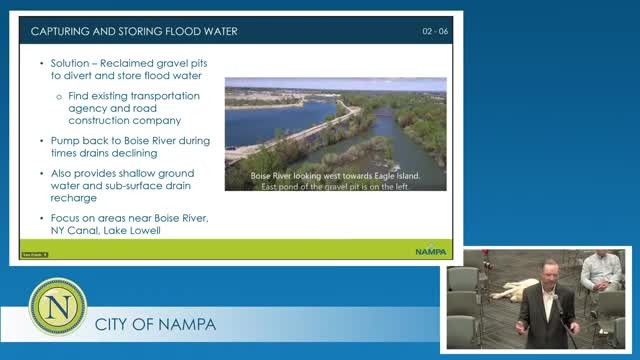Nampa plans innovative floodwater capture project
July 19, 2024 | Nampa, Canyon County, Idaho

This article was created by AI summarizing key points discussed. AI makes mistakes, so for full details and context, please refer to the video of the full meeting. Please report any errors so we can fix them. Report an error »

In a recent government meeting, officials discussed significant water management strategies for the Boise River drainage area, focusing on floodwater storage and conservation efforts. The meeting highlighted the potential to capture and store up to 1 million acre-feet of floodwater, which could be reused during the irrigation season. This initiative aims to address declining drain flows caused by urbanization and increased water recycling by irrigation districts.
Key stakeholders, including the Treasure Valley Water User Association and local irrigation districts, expressed support for the project, emphasizing the importance of collaboration to mitigate conflicts over water rights. The discussion also touched on the need for a sustainable approach to water management, particularly as urban development alters traditional irrigation practices.
The officials outlined a phased approach to the Treasure Valley Water Users Sustainability Study, with current efforts focused on data collection and modeling. They are exploring the use of nearby gravel pits for floodwater storage, which could provide a cost-effective alternative to expensive pipeline solutions previously considered.
Additionally, the meeting addressed the cultural wetland project aimed at improving water quality by removing toxins from local waterways. This project is expected to have downstream impacts, prompting proactive engagement with irrigation districts to avoid potential protests over water rights.
As the region faces challenges related to declining drain flows, officials stressed the importance of using scientific data to develop effective solutions. The meeting concluded with a commitment to ongoing collaboration among water operators and stakeholders to ensure sustainable water management in the valley.
Key stakeholders, including the Treasure Valley Water User Association and local irrigation districts, expressed support for the project, emphasizing the importance of collaboration to mitigate conflicts over water rights. The discussion also touched on the need for a sustainable approach to water management, particularly as urban development alters traditional irrigation practices.
The officials outlined a phased approach to the Treasure Valley Water Users Sustainability Study, with current efforts focused on data collection and modeling. They are exploring the use of nearby gravel pits for floodwater storage, which could provide a cost-effective alternative to expensive pipeline solutions previously considered.
Additionally, the meeting addressed the cultural wetland project aimed at improving water quality by removing toxins from local waterways. This project is expected to have downstream impacts, prompting proactive engagement with irrigation districts to avoid potential protests over water rights.
As the region faces challenges related to declining drain flows, officials stressed the importance of using scientific data to develop effective solutions. The meeting concluded with a commitment to ongoing collaboration among water operators and stakeholders to ensure sustainable water management in the valley.
View full meeting
This article is based on a recent meeting—watch the full video and explore the complete transcript for deeper insights into the discussion.
View full meeting